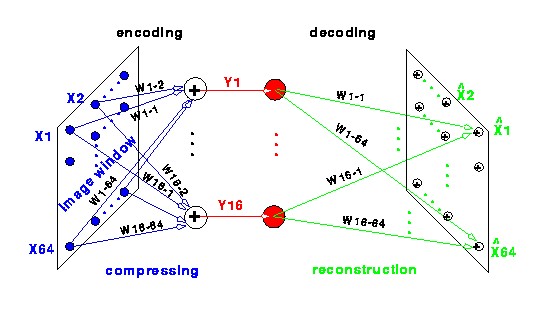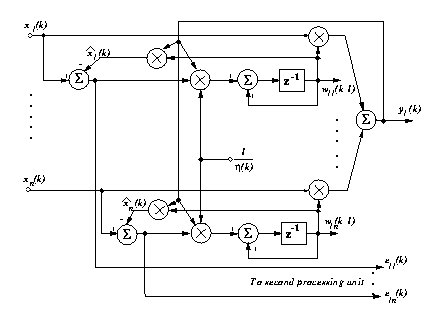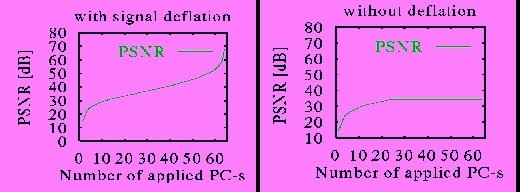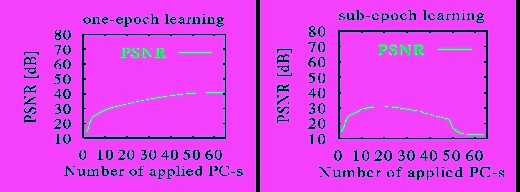ANN for Principal Component Analysis
Motivation
The following image compression-reconstruction scheme
may be applied for images (Fig.1):
Example:
The work of Prof. Cottrell and his co-workers
(UCLA in San Diego) and recent work of Valentine, Abdi
document the importance of different range
principal components for classification of face images according to
sex and view direction (pose).
We have developed a new fast learning algorithm
for neural network based PCA, called
CRLS (cascade recurrent least square) PCA
Consider our important paper published in "Cybernetics and Systems", 1996.
The main features of this learning algorithm are:
sequential PC extraction with a Hebbian like learning rule,
deflation of input signals,
an RLS scheme for automatic adaptation of learning rate.
We found it impossible, without signal deflation
properly to extract the intermediate and lower range PC's
by other neural PCA algorithms
(as well as by the neural PSA algorithm).
On the drawing in Figure 4 the quality
of image compression-reconstruction by PC-s learned with signal
deflation (left drawing) and without it (right drawing) are shown.
Fig. 4
This difference is usually only quantitatively measurable
but may not be visually detectable.
In the two-image animation
Adjust your mpeg_player to high quality
(e.g. set option -dither color if this is possible on your display).
The learning rate in every cascade of the neural network
is automatically initialized and adaptively updated
according to the energy of input signal
and a RLS (recurrent least squares) scheme.
This RLS scheme for learning rate adaptation
allows a fast learning, usually in one epoch of the image data.
This means, that no iteration of the input sample
may be required (on--line learning)
if the relation of one data sample size (image window)
to complete image size is small enough
(e.g. a 64-pixel window moving over an
512x512-pixel image). This number depends
on the homogenity characteristics of every single image.
The number of learning samples itself
can not be shortened without limitation.
In the movie below results of image compression-reconstruction are shown
for two cases: one-epoch learning on full image
data of every single principal component (m epochs for m PC's)
(left image) and learning in half epoch (half image data, no iteration)
of every PC.
This time we have additionally normalized the learned weight vectors to 1
(as they should be after a complete learning convergence)
in order better to demonstrate
the visual quality of learned PC's.
The addition of badly approximated intermediate and lower range principal
components leads to degradation of the reconstructed image.
Fig. 5
The advantage of principal components is their generalization strength.
PC-s that have been learned on one image
from some class (e.g. natural images)
can be applied very well for compression-reconstruction
of other signals from the same class.
Take a look on the 4-image animation,
a MPEG movie (375 kB), below
Compare the sequence with the original 4 images
given below as a high quality
If the learning process is continued on new images
the learning rate should be initialized again
for every new image.
We also have introduced a matrix form of the learning rate
and its adaptation according to the RLS scheme
for the PSA (principal subspace analysis) and
ordered PCA (e.g. the Brockett algorithm).
We obtained fast learning algorithms, that are able
to learn an approximation of highest range
components or subspaces with reasonable quality.
See our paper published at ESANN 1996.



 after 3-th principal component
after 3-th principal component


The CRLS PCA method
Thus CRLS PCA is a simple
neural network learning method that outperforms other
similar neural network methods in the speed-to-quality factor,
and that properly extracts all
components (not only the highest range but the intermediate
range and minor components also).
Although for experimental validity
of the method an image compression-reconstruction
cycle was usually used, an image compression application
was definitely NOT our motivation,
as there are already very well established compression standards.
Our main motivation was to derive a biologically justified
(i.e. a learning method)
which is able to compete with well known
numerical approaches to PCA.



 MPEG (1.66 MB),
MPEG (1.66 MB),

 (MPEG, 2.04 MB)
(MPEG, 2.04 MB)

 JPEG image (203 kB).
JPEG image (203 kB).
RLS learning rate in matrix form for PSA and ordered PCA methods
[go back to top],
W. Kasprzak
Apr. 1996